This is a Chinon CE II Memotron 35mm SLR camera from 1976. This model was one of the very last 35mm cameras released by any company to still use the aging M42 screw mount. It’s headline feature was that it was capable of open aperture auto exposure using almost any M42 screw mount lens. Other companies like Yashica and Pentax had released their own models which supported open aperture auto exposure, but they were limited to open aperture metering to specific lenses. Without a compatible lens, the camera could only meter when the lens was manually stopped down. This model, along with its predecessor and successor, are to my knowledge, the only cameras ever made that could meter wide open using the M42 screw mount. This feature alone made this camera relevant in the market as it offered one last hurrah for photographers with a large collection of M42 glass who wanted auto exposure without having to start over with an all new lens mount.
Film Type: 135 (35mm)
Lens Mount: M42 Screw Mount
Lenses: Auto Chinon 55mm f/1.7 coated + any other M42 lens
Focus: Fixed SLR Prism
Shutter: Focal Plane Vertical Metal Blade
Speeds (Electronic): 2 – 1/2000 seconds, stepless
Speeds (Mechanical): B, 1 – 1/2000 seconds
Exposure Meter: Dual Silicon Blue Cell (SBC) TTL Center Weighted meters
Battery: PX28 6v Silver-Oxide or Alkaline equivalent
Flash Mount: Hotshoe + dual PC M X sockets
Manual: http://www.butkus.org/chinon/chinon/ceii-metrotone/ceii-memotron.htm
History
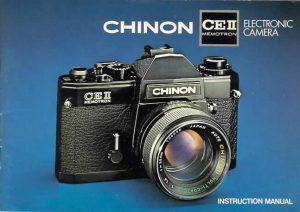 Chinon is a name not often associated with collectible cameras. For those active in the 1970s, you probably remember them as a maker of discount screw mount and Pentax K-mount SLRs. Their cameras were actually well built, but they weren’t exactly a company known for innovation. In fact, many Chinon made cameras were rebadged and sold under the brand names of other manufacturers such as Argus, GAF/AGFA, Revue, Sears, Alpa, and Albinar. As a result, there are far more Chinon made cameras out there than most people probably realize.
Chinon is a name not often associated with collectible cameras. For those active in the 1970s, you probably remember them as a maker of discount screw mount and Pentax K-mount SLRs. Their cameras were actually well built, but they weren’t exactly a company known for innovation. In fact, many Chinon made cameras were rebadged and sold under the brand names of other manufacturers such as Argus, GAF/AGFA, Revue, Sears, Alpa, and Albinar. As a result, there are far more Chinon made cameras out there than most people probably realize.
The company was originally formed by Chino Hiroshi in September 1948 as Sanshin Seisakusho in Tokyo, Japan. Unlike other Japanese optical companies of the time, Chinon seemed to be in the business of making parts for other optics companies. As best as I can tell, in the 1950s, they made camera lens frames and lens barrels for a variety of companies. It doesn’t look like Chinon had any of their own optical products until 1958 at which time they released their first 8mm motion picture camera lens.
The company would change it’s name in 1962 to Sanshin Optics Industrial Co. Ltd, and then once again in 1973 to Chinon Industries Inc. As best as I can tell, the company’s first 35mm camera was made in either 1971 or 1972, and I believe it was the Chinon M-1, a rather basic mechanical SLR with an M42 lens mount.
Finding a comprehensive history of Chinon and their early products has proven to be a bit of a challenge, so I’ll just skip to the point where Chinon decided that perhaps it was time for them to make some kind of innovative contribution to the camera industry.
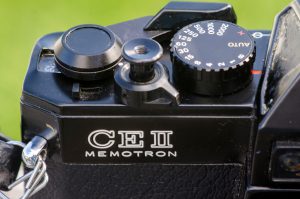
In 1974, Chinon would release the Chinon CE Memotron. It was a well built camera with an excellent metal blade focal plane shutter capable of speeds from 2 to 1/2000 sec. It was Chinon’s first camera capable of auto exposure, but how they accomplished it with the M42 mount was slightly different than what anyone else had done.
Its worth noting that by 1974, most of the industry had moved away from screw mount lenses. Originally designed by Zeiss-Ikon prior to World War II, the first M42 cameras did not become available until the Contax S in 1949. The benefit of a screw mount lens is in it’s simplicity. The lens flange on the camera and the lens itself has a simple threaded screw pitch which mates the camera and lens together. The M42 screw mount was used by many manufacturers throughout the 50s and 60s like Praktica, Asahi Pentax, Yashica, Petri, KMZ, Fuji, and eventually Chinon.
As cameras became more advanced, the need for a camera body to “communicate” with it’s lens became more and more necessary, especially when it came to automatic exposure as the camera would need to know which aperture was selected on the lens. As a result, bayonet or breech lock lenses started to become common with most manufacturers because the lens was always in the same orientation at all times while mounted.
A few workarounds were created for the screw mount, the first of which which was a “stop down” pin that would be activated by a sliding bar located beneath the mirror in the mirror box of the camera. This would allow a photographer to compose an image at maximum aperture regardless of what was selected on the lens, and then upon pressing the shutter release, the bar would push the pin, which would cause the lens to stop down to the selected aperture moments before the shutter would fire. This was fine for manual exposure calculation because the photographer had ultimate control over shutter speed, but it posed a problem for auto exposure sensors since the camera wouldn’t know what aperture was selected until moments before the shutter fires. There had to be a way for the exposure meter in the camera to know what aperture was selected on the lens before pressing the shutter release.
A couple of companies like Yashica and Asahi Pentax attempted to overcome this issue by creating new lenses that had a second pin on the lens flange that would indicate which aperture was selected. The camera would be able to detect the selected aperture on the lens by sensing where this pin was and then automatically select an appropriate shutter speed based on the amount of light that was detected by the meter. This worked quite well, except that it required special lenses with this second pin.
Edit 12/1/2016: After posting this review, I was corrected that the Yashica Electro AX SLR was capable of open aperture auto exposure without a special M42 lens mount. The Electro AX had an awkward auto exposure system that would always stop down the lens any time the shutter was cocked. In order to compose your image wide open, you had to press and hold an override button on the front of the camera and release it before firing the shutter. Also, due to changes in the reflex mirror, the Electro AX was incompatible with some M42 lenses, including several of Yashica’s own Yashinon-DX lenses which were popular at the time. So while the Electro AX did have aperture priority AE capability without a special M42 lens mount, it’s implementation was awkward and certainly not as simple as that of the Memotron.
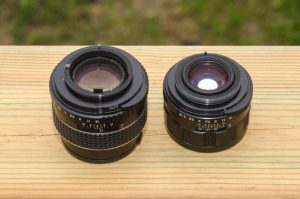
Look at the picture to the left of an Asahi SMC Takumar side by side with a “regular” Takumar. The SMC Takumar was designed specifically for the Pentax ES and ES II which also had an AE system. The sliding pin needed for open aperture auto exposure on the ES is in the foreground of the lens on the left. Also on the SMC is a square metal stop on the outer ridge of the M42 mount. This acts as a firm stopping point so that the lens cannot be “overscrewed” onto the camera. This is required to assure that the sliding pin is always in the exact right position. All of these changes needed to be made to these lenses to allow for the AE system to work properly.
If you tried to mount an existing M42 lens without these new features, the camera would have no way of knowing which aperture was selected. In those cases, the auto exposure system could still be used, but only by manually stopping down the lens first. This would not only darken the viewfinder and make composition more difficult, but would also slow down the process of making a photo, thus defeating one of the primary goals of an auto exposure system.
Chinon tried a different approach that was actually simpler than either Yashica or Asahi’s methods, but also had the benefit that it would work on any M42 lens, as long as it had the auto stop down pin which by 1974 was extremely common. How it would work is that with a half press of the shutter release button, the auto stop down pin would become engaged at which time the meter would be turned on and take a reading a split second before firing the shutter. If you just wanted to see the selected reading, you merely had to half press the shutter release and hold it. Half pressing the shutter release also illuminates a green light beneath the viewfinder which acts as a “meter ready” indicator. When the light is on, the camera has sufficient power to enable the meter. If this light does not illuminate, you should replace the battery.
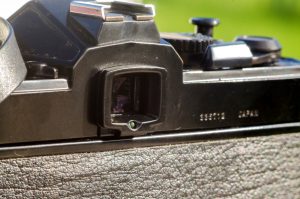
Modern cameras can auto focus on an image with a half press of a shutter release, and although this wasn’t an auto focus camera, this had to have been one of the earliest examples of a camera that would perform some function with a half press of the shutter release.
But wait, there’s more! Chinon had another trick up their sleeve which was the “Memotron” feature. Upon half pressing the shutter release, the camera would retain it’s detected exposure settings and hold it. This was useful if you wanted to expose for a different part of a scene and then hold the exposure settings and recompose the image. This would have helped on brightly backlit or front lit scenes where the camera might not get the exposure correct.
Other than not requiring a special lens, the biggest advantage of this system is that if all you wanted was an aperture priority auto exposure camera, you would set your desired aperture, compose your image with the lens wide open, and then press the shutter release all the way down and the camera would do the rest for you. There was no additional step to manually stop down the lens first. While all of this sounds terrific, it had the side effect of requiring that the shutter release be taller and have a longer travel to allow for all of the things that needed to happen during it’s travel. As a result, the CE II Memotron has the longest travel of any shutter release on any SLR I’ve used.
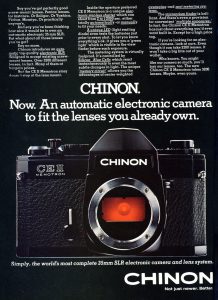
Chinon wisely used this feature in their advertisements for the Memotron saying that you could have an automatic electronic camera using the lenses you already own. I could not find any information regarding production numbers of the Memotron series, but it had to have been at least somewhat successful as Chinon would make 3 different revisions of the CE Memotron all with an M42 mount.
The first CE Memotron was released in 1974 and then in 1976, the CE II Memotron was released which was essentially the same camera, except it had a new battery compartment, a provision for double exposures, and a shutter curtain blind to block light from entering the viewfinder for long exposures. Otherwise the two cameras were nearly the same.
In 1977 came the CE-3 Memotron. Still using the M42 mount, the CE-3 Memotron was a significantly different camera. For one, it had a much smaller and lighter weight body. This was in keeping with the trend of more compact and more portable SLRs like the Canon AE-1 and Nikon FM/FE. The CE-3 lost the top 1/2000 second top speed and could only go as fast as 1/1000 second but it extended its slow speed to a max of 4 seconds, instead of 2 like on the earlier models. Other changes to the CE-3 Memotron was a switch to two S76 silver-oxide batteries and support for an accessory power winder.
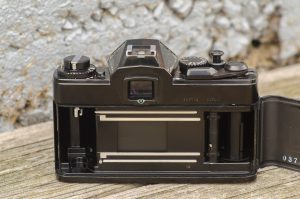
The M42 Memotrons definitely extended the life span of the M42 mount and allowed photographers with a large collection of lenses to use them in a more modern way, but by the end of the 1970s, the decision was made to finally abandon the screw mount. In 1979, Chinon would release the CE-4 Memotron using the Pentax K-mount. From this point forward, all future Chinon cameras would use the K-mount, and the era of the M42 screw mount would officially be over.
Today, the Chinon Memotrons seem to largely go unnoticed in the used market. I think the biggest reason for this is the relative insignificance of the entire Chinon brand. Other than the Memotron, Chinon’s biggest contribution came by making cameras that were rebranded for someone else. Their products were actually pretty well built, and in the case of the Memotron series, had some ingenious features. Nevertheless, these cameras don’t often show up for sale very often, and when they do, they often don’t go for much.
My Thoughts
One of my favorite classic cameras is my Asahi Pentax Sv. Its an extremely well built and compact SLR with excellent ergonomics, and it pairs with Asahi Super Takumar lenses, which are some of the best SLR lenses made with any mount by any company. I love my Super Takumars so much, that I bought an M42 -> Nikon F mount adapter and use them regularly on my Nikon D7000 DSLR. Many of the glamour shots used for reviews on this site were taken with a Super Takumar because of their excellent sharpness, color rendition, and ease of manual focus.
As I explored what other cameras I could use my M42 lenses with, I discovered Yashica’s M42 SLRs like the TL-Super, and the TL Electro X. With those cameras came more excellent M42 Yashinon lenses to my collection.
Soon, I found myself with a library of some truly spectacular screw mount lenses, and as much as I loved the cameras they were intended for, I wondered what an auto exposure camera could do with them, and thus began my search for a model capable of auto exposure. First came the Pentax ES II which I reviewed on this site. I had some issues with that camera, namely with the meter which allowed me to shoot the camera manually fine, but the auto exposure system wasn’t reliable. Since many ES IIs rarely sell for the bargain prices that I usually look for, I had a hard time finding one that I wanted to pull the trigger on.
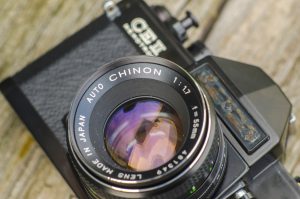
Then one day, I received a private message from fellow collector, Mike Novak, and he alerted me to a Chinon CE II Memotron with Chinon f/1.7 lens on eBay with a mysterious Buy It Now price of only $10. The camera looked pretty good, and thinking it was a mistake, I bought it.
When the camera arrived, I was pleased to see that it seemed to be in good working condition, but it had some condition issues. For one, the leatherette body covering on top of the prism was missing. Also, the viewfinder had quite a bit of dirt and possibly some desilvering inside of the prism. Nothing that seemed to affect normal use of the camera, and for the price, I shouldn’t complain, but I was a bit disappointed that the camera wasn’t in better shape.
Like I do with every pre-80s vintage SLR, I replaced the foam light seals in the film compartment on the hinge, wiped the body down, loaded in some film and went shooting. I had some family visiting from out of town, and we were headed to the Indiana Dunes on a Saturday, and knowing that a sandy beach is the absolute worst place you could take any camera, I decided that if I was going to bring something, it should be something with relatively low risk, so I loaded up the Chinon and took it with me.
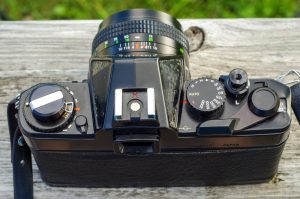
Shooting with the camera was a mixture of good and just OK. The good is that the camera feels solid and it’s ergonomics are about what you’d expect of a mid 1970s SLR. All controls are in a logical location, and the viewfinder is large and bright. A big plus to the Chinon compared to the Pentax ES II is that auto exposure works with “regular” M42 lenses without having to reach for a manual meter switch.

On the negative side, the Chinon’s shutter release is taller than any other SLR I’ve ever used, and it has a very long throw. I mention the reason for this earlier in this article, and it’s certainly not a deal breaker, but it is something that takes a little bit to get used to.
Although the viewfinder is large and bright, it’s only focus aide is a microprism dot in the center. There is no rangefinder aide which had become quite common by the mid 1970s. I can forgive this omission on earlier SLRs, but you’d think that this should have been standard fare by the time the CE II hit the market.

The camera is also not lightweight. Using an SMC Takumar 50mm f/1.4 lens, the Chinon weighs a hefty 1012 grams, topping the ES II with the same lens at 937 grams. This might not seem like much, but if you prefer an M42 all manual experience, you could carry around the Pentax Sv which is a relative featherweight, weighing only 862 grams using the exact same lens as the other two.
None of this adds up to a terrible shooting experience, but since the reason for owning this camera was it’s auto exposure mode, it better do a good job if a user is to overlook these shortcomings.
My Results
My goal when shooting with this camera the first time was to test how useful an auto exposure mode could be on a screw mount camera. Surely, the Chinon CE II Memotron was pushing the boundaries of what could be done with an M42 camera, but what kind of compromises would there be? If I was an advanced amateur photographer in 1976 with a large selection of screw mount lenses, and wanted to try out auto exposure, but didn’t want to invest in an all new bayonet mount, was this camera worth a purchase?
Assuming that the Chinon 55/1.7 lens would give me at least decent results, I took the camera to the beach and exposed it to high contrast scenes with lots of movement, in an attempt to test how useful Auto Exposure might have been.
It’s worth a comment that I completely realize taking any sort of precision instrument to the beach is a terrible idea, and not one I would normally expose a valuable camera to. While the Chinon CE II might have been a mid-level camera when it was new, it only cost me $10, so I was willing to risk exposing it to sand, and even carrying it with me into Lake Michigan for some shoreline shots.
Before I comment on the exposure meter, I have to say that the Chinon lens exceeded my expectations in sharpness, clarity, and color rendition. I already hold my selection of Asahi Super Takumar screw mount lenses in very high regard, but I don’t know that I would be able to tell the difference between this Chinon lens and any of those lenses. In fact, I wouldn’t be surprised if this lens is a clone of the designs used by someone else. I have found no proof to support or dispel that theory, but whatever is going on inside that lens, is purely magical.
In terms of the auto exposure capability, I can honestly say Chinon’s magic goes beyond the lens. In the very first image of the gallery above, I intentionally took a picture of a child in front of a backlit window to try and trick the meter, yet neither the yard outside of the window is blown out, and there is still sufficient shadow detail in the foreground to have a usable image. I am not convinced that a modern DSLR could have done any better.
For the rest of the shots, while most of them were shot on a bright and sunny day, there was constant fast motion in nearly every shot. Many AE systems can be fooled by high contrast images, rendering blown out highlights or murky shadows yet that didn’t happen here. I used Fuji 200 film for this roll and I’ve seen that film’s limits reached on other cameras like the Fujinon 35-ML but in the Chinon, the images all came out with perfect exposure without any of the maladies that can often plague lesser AE systems.
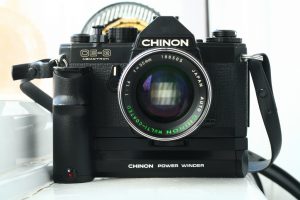
If I had to come up with some way that this camera could have been improved, it would have been to put it in a more compact design (like the later CE-3 Memotron), and figured out a way to not have the shutter release so tall. I would have also preferred a split image focus aid in the viewfinder, but based on the perfect focus in every image on my test roll, I clearly didn’t need it.
The fact that a little known company like Chinon was able to implement a working AE system using nearly ANY screw mount lens in 1976 when nearly everyone else had moved onto more capable bayonet mount lenses, and do it with near perfection is damned impressive. Yashica and Pentax tried, but even they couldn’t get it right.
I cannot understand how Chinon didn’t have more success as their engineers were clearly talented. I don’t know if it was over saturation of the market, or if there was some type of corporate mismanagement, but whatever the reason, this is possibly one of the most impressive results I’ve seen from any camera made by a company more known for selling rebadged cameras under other names, than their own designs.
My Final WordHow these ratings work |
The Chinon CE II Memotron is a very unique camera in that it allows aperture priority auto exposure using any screw mount lens with an auto stop down pin. This means that you can meter wide open using any lens made by Asahi, Yashica, Praktica, Zeiss, or any other manufacturer. If that wasn’t enough, the AE system is surprisingly accurate and works just as well as the systems in use by any other camera maker. It is a well built and sturdy camera with a vertically traveling metal blade shutter with a top shutter speed of 1/2000 seconds. This camera was designed to prolong the usefulness of M42 lenses, and it still serves that purpose today. These cameras aren’t exactly common, but if you have an opportunity to pick one of these up in working condition, I absolutely recommend it! | ||||||
| Images | Handling | Features | Viewfinder | Feel & Beauty | History | Age | |
| 2 | 1 | 2 | 2 | 1 | 2 | 0% | |
| Bonus | +1 for being the only screw mount camera series to do AE correctly without needing proprietary lenses | ||||||
| Final Score | 11.0 | ||||||
Additional Resources
http://photo.net/classic-cameras-forum/00Z1A7
https://www.zorkiphoto.co.uk/2013/05/chinon-memotron-review/
http://anusf.anu.edu.au/~aab900/photography/cameras/chinon.htm
http://blog.bkspicture.com/review_Chinon_CEII_Memotron.html
https://www.flickr.com/photos/nefotografas/sets/72157624974442535/

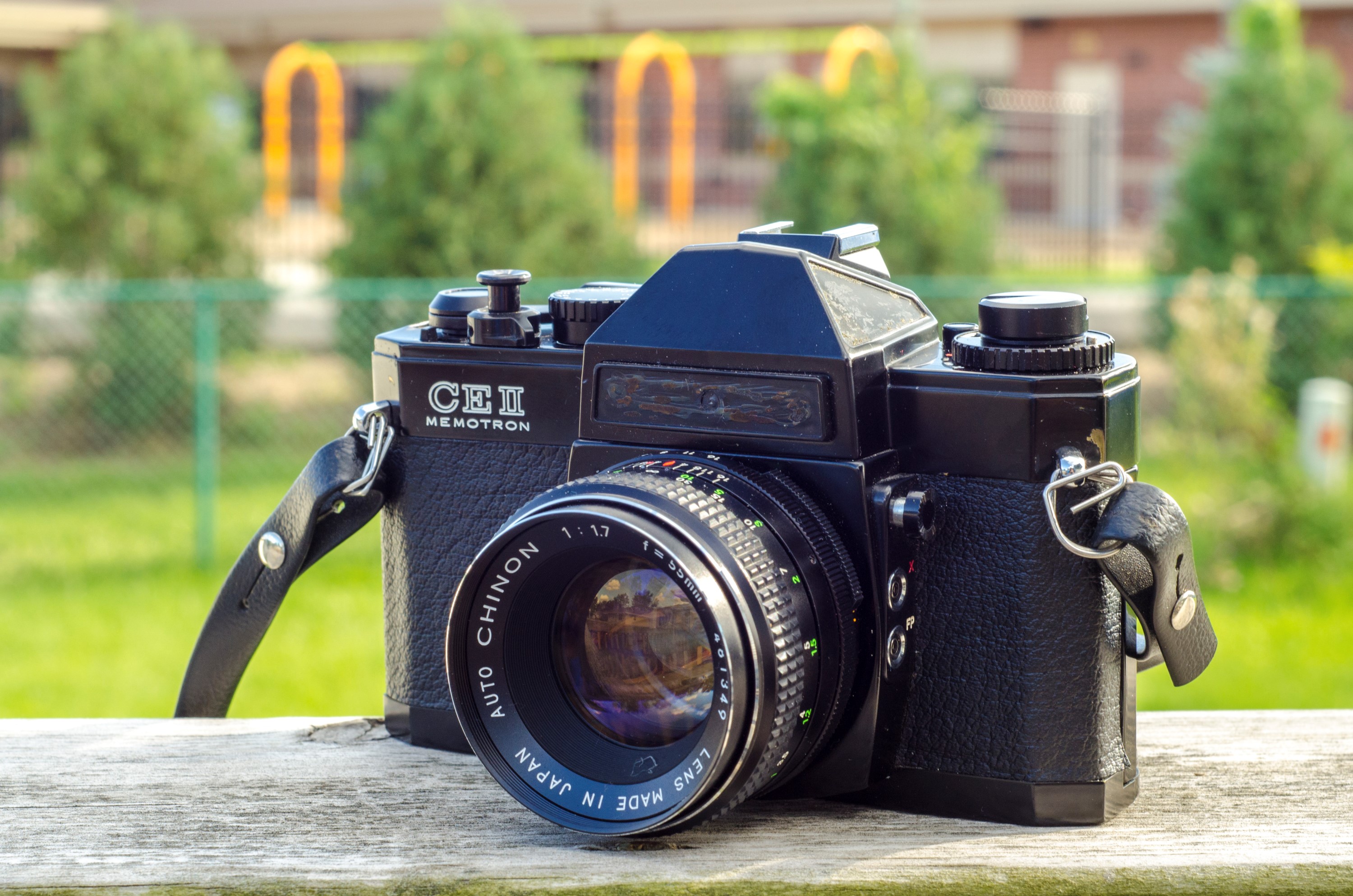
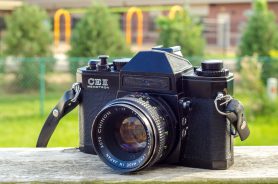
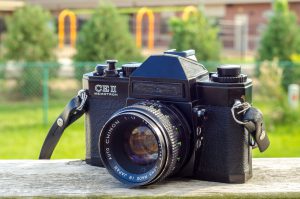








I can’t lie – had I seen this camera sitting in case along a bunch of Chinon, Ricoh, Fujica, and other similar 70’s “second tier” SLR cameras, I’d have had no clue of just what a special little beast that it is. I’d have ignorantly dismissed it as a knock off of unknown mount that I wouldn’t get any takeaway from. Instead, you’ve enlightened me to realize that there are some real gems out there with otherwise overlooked names that are well worthy of consideration in the future! Well played Sir!
Loved my CEII! Built like a tank. A zip-loc converted it into a boat anchor or wheel chock. Auto with over-ride features that made it dance under one’s finger-tips. The only problem was a recurring film-transport malfunction that made carrying a changing bag mandatory or some crafty work with a jacket and/or local cave or lava tube (when available). What a grand old friend and treasured companion! I carried other bodies for other films, of course, but the CEII was dear!
Hello James I bought a Memotron that seemed in excellent condition however I just spoilt my first 2 rolls. I seem to have exactly the problem you mentionned: the film is loaded just fine at first, and then there is no resistance. In the end the roll is just empty and I wasted time, money and am extremely frustrated. Of course I could have noted it earlier, I guess. I suspect the small button at the bottom was pressed “on its own” which would explain why this happens. How did you solve your problem, what did you do with it? I dont dare trying to load a 3rd film in there to be again disappointed after 2 weeks. i haven’t seen a singe photo yet 🙁
Hello and thanks for posting this article on an underrated classic. I have both a GAF L-ES (rebranded Chinon CE Memotron) and Yashica AX.
Several times you mention that both the Chinon Memotron and Yashica AX provide open-aperture auto exposure, which is incorrect (both meter at working aperture, stopped down). What made these two cameras special is not that they are AE screw-mount SLRs (there were at least a half-dozen others on the market) but that because they didn’t modify the lens mount for open-aperture metering, there were no compatibility issues using other brands of lenses, making them more versatile. Other manufacturers modified their mounts for open-aperture metering using coupling pins or lugs (Pentax, Fujica) or electrical contacts (Praktica, Zenit 18). The Pentax ES II, Fujica ST901/AZ-1, and Praktica EE2/EE3, in fact, could also provide AE exposure in stopped-down mode with standard M42 lenses.
On the topic if why Chinon wasn’t more succesfull in their business: in the Netherlands, they refused to let photography magazines keep the reviewed camera. Other brands like Nikon, Canon, Leica etc did ‘donate’ the camera to the magazine, allowing the journalist to get one to get one at a discounted price or for free.
Chinon was mentioned as an example of the manufacturers that by principle did not do this, in the post I read online, which was by a former photography magazine editor. He stated that the brands that refused got less favourable reviews and less millimeters print in the magazines.
It’s been suggested that the auto exposure method was actually inventeded by Cosina and I believe they marketed an ugly camera using it that was much more obscure than the Chinon implementation. I think it was Chinon that got it working reliably, The Cosina Hi-Lite EC looks like a rebadged Chinon CE! I owned the Chinon, GAF, and Alpa-branded versions and they were my main cameras between the Exakta VX-1000 era and the Minolta X-700. I have also heard that the X-700 used this idea of metering after the lens has stopped down to implement its programmed exposure mode.
The Chinon-made cameras I had had a pretty reliable basic mechanism, but with age the finish wore off, fake leather peeled off, the shutter speed indicator became inaccurate or inoperative, etc. They usually died of electronic failures, preshadowing the DSLR;-)
Mike, you forgot to mention Chinon’s multi-function auto winder. None other like it. Chinons were sold in Germany under the Revueflex brand. Chinon/Revueon 55/1/4 Multi-coated Auto lenses are top quality, lots of glass, big and heavy. I’ve had my Revueflex bodies CLA’d with no problems.
Almost none on US eBay, but German/French/UK eBay sites have most of these bodies and lenses and winders. I use mine a couple times a week. I grew up with manual cameras so the your Pentax Sv is fine. CLA both the bodies and lenses, recover with leather and what’s not to like?
Mike, you were disappointed that a $10 eBay camera wasn’t in better condition? There are leather replacement covers for any camera ever made, $30 or so. Split image range finders were created for lazy people. Point the camera to some object which is approx the same distance as your subject, focus on it, then swing the camera back to your subject. Presto! ANY Chinon/Revue color coated 55/1.7, especially their color coated 55/1.4, are astounding lenses (55/58 mm is the true “normal” lens and has been since the 30’s – 50 mm lenses are more wide-angle). See their prices – if you can find them. Too heavy? For whom? Surely not for the professionals who traveled the world with 8x10s, surely not for us who grew up with 4x5s. It might be because of today’s light-weight people instead of the camera. No military experience?
Daisy, I am sorry if my review is not consistent with your thoughts on the camera. Hopefully you read the whole thing though where I stated I was very impressed with the shots of the camera and my 11.0 score is one of the highest scores I’ve ever given to a camera.
Regarding the split image focus aide, I disagree its for lazy people. I am very visually impaired. I am legally blind in my right eye and in my left eye, I wear lenses with a -9.75 correction. I struggle with microprism focus aides and find that the split image viewing screens are easier for me to use. Even without one though, I was still able to get properly focused images, as you can see from the gallery above.
And finally the weight, this camera is heavy. Of course its nowhere near as heavy as an 8×10 field or 4×5 camera. I dont know how you got to that conclusion. But compared to other SLRs of the era, the Chinon is heavier. I talk about the weight of cameras in almost every review I write. It clearly did not stop me from giving the camera a very favorable review, however.
Hello Mike,
I just read your review and noticed a small error: the Chinon CE II Memotron had 2 silicon blue cells for metering, no CdS cells. Chinon used these SBCs as an advertising argument, because the SBC was much faster than the CdS. This was important i. e. when you followed fast moving objects through changing light conditions.
Well, I’m a proud owner and former user of a Chinon CE II Memotron…
Thank you,
Gunter
Thanks for the correction Gunther! I have updated the review to state the meters are SBCs and not CdS! 🙂
I just got email saying there was a new post here but I don’t see one. While I am here and rereading the old stuff I think the situation with the metering is still not clear. If you have ever used one of these cameras, you will have noticed the very long and stiff travel of the shutter button. What’s going on is that you are first stopping down the lens, perhaps with some extra resistance to slow you down. Then farther down in the travel the meter is turned on and light is measured AT SHOOTING APERTURE. The silicon cells make it possible to do this very rapidly, and pressing the shutter farther a bit farther lowers the curtains. I think the release is long and stiff partly to keep you from firing the shutter before the meter is done, and partly because you are making all this stuff happen with one finger power. There was a full discussion of all this in whatever photo magazine Herbert Keppler was with at the time this came out. In their tests they never managed to beat the meter nor did I with any of the versions of this camera that I owned. In operation it felt like wide open metering but that’s not what was really happening.
I just scored the GAF L-ES version of the memotron in Black and covered in lizard skin… it’s unique for sure, finally got a battery and I’m going to try it out soon, it was cheap without a lens, but I have a spare Mamiya 50mm 1.4 from a thrift store. Chinon Memotrons were also sold be Sears, GAF, and even Whoever owned the Argus brand at the time. All of the rebranded memotrons I’ve seen have the letter E in the model name, which can help distinguish them from similar looking rebranded Cosina and Chinon cameras that dont have the same metering and auto exposure capability. Another distinguishing spotting feature is the unusually tall shutter release.
Great info, Eric! I dont think Ive ever seen an Argus variant of this camera, but I do know that M42 Arguses do exist. I believe Petri made some of them too.
The Argus version looks different. Has a large square patrimony housing, but there are similar looking models that don’t have the memotron features. I also have an Argus STL 1000, mine is a clone of the Cosina hi-lite. But the same model number was used for other versions including one that was made by Petri.
Hats off Mike. A good friend of mine just came across the GAF rebadge of this camera – she asked me about it and I had no idea what it was and assumed it was a cheap clone. Thanks for the enlightenment and thorough article as usual.
Glad I could help! As you noted, this is certainly not a cheap clone! Hopefully your friend has an opportunity to clean up that GAF, load in some film, and take it for a spin!
I had both the Memotron and ES back in the 70’s and the Memotron was a joy to use however the ES always seemed to have the edge in terms of results. The Memotron also ‘introduced’ the 55mm f1.2 m42 mount (which I also had) made byTomioka later bought out by Yashica and offered with their m42 & Contax mount cameras. An interesting lens now fetching mega bucks.
Another minor point, the square lug on the SMC Takumars did not stop the lens being screwed too far. The camera ‘read’ the set aperture by gauging the distance between the square lug and the aperture pin on the two internal levers in the lens mount. Thus compensating for any minor variation in the seating of the lens .
I just wanted to drop my 2 cents here. I own a CE-III Memotron, that I got fairly recently (probably a month ago). Actually just got a power winder for it on ebay for the unbeatable price of 0.99 GBP. I love the camera. Already went through few films and the results are excellent, metering seems always spot on. The only thing I don’t like about it, is that the shutter has some “recoil”, but I will eventually learn to compensate for it. The only other thing I don’t like about the CE-III is that it goes only up to 1/1000 while CE-II goes to 1/2000. I’m currently browsing either for a good deal on a CE-II or I’ll just get some ND filters. My camera came with a SBC Fujinon 55/1.8 that has some fungus on the edges and I plan to clean thoroughly once my lens cleaning kit comes in the mail, but I just love it. I am lucky to be able to find some good M42 glass in flea markets on the cheap and I’m planning to stick to the Chinon. It is an awesome camera.
Interesting post, Mike. I own a GAF L-17 which is a rebadged Chinon M-1. The camera takes beautiful pictures. I might have to find one of these Memotrons.
I also have the Chinon 50mm f1.9 K-mount and it is a stellar lens. Anyone who sleeps on Chinon is missing out on some genuinely godd gear.
FYI, I own a Vivitar XC-3 that has a half press mechanism similar to the Memotron. The XC-3 was built by Cosina.
I couldn’t agree more that Chinon stuff is generally pretty awesome. I also had a Chinon CE-4 with a Chinon lens and it regularly returned outstanding results that were impossible to differentiate from something shot with a Nikkor or Zeiss lens.
Great article, with very informative explanation on an auto feature. I am about to buy M42 body and Chinon CE-3 looks interesting, although I have some doubts. I see this is an article from a few years ago, but maybe you could help. I wonder how the metering works in manual mode, if I set exposure by myself , does the camera provide any info on choosing the right aperture? Also, have you encountered a problem with seeing the meter needle in low-light conditions? It seems like it’s all dark, which could prevent from seeing it clearly when shooting in dark environment. I would be glad if you could explain some of these aspects to me, as there isn’t much info on these models available, although they seem like very interesting cameras.
Mike Butkus has the manual free online. I owned several of these but film is dead where I live and so I sold all my film gear long ago. Perhaps someone who has a working model can check my memory, which is that manual metering is no fun. The instructions give some workarounds. Another possible option is to set the shutter speed you want and then fiddle with the aperture until the needle indicates the set shutter speed. Then open or close the lens as desired from there. However, my experience was that the shutter speed indicator was just a courtesy — not very accurate nor long lived.
I’ve seen the manual, I must have missed the manual exposure part. Thanks for your feedback. I have the posiblity to buy near-perfect condition Revueflex AC 1 (Chinon CE-3) with Pentacon 1.8 50mm lens and some stuff (flash, macro rings, teleconverter, and remote shutter release cable), all for around ~$50. I thought it would be nice setup, as I am just beggining my journey with SLRs, however I’m not sure if this camera is “manual” enough for me. I have another Zenit with Helios lens though, which is much more basic, so I would be able to use it and also change lens between them. I just thought auto feature of Chinon would be nice sometimes…
I would like to point out, that some of the chinons (as well as some sears, revuenon, mamiya/sekor) were tomioka made. Which is quite sought after. I actually bought this camera with 2 lenses just because it had a chinon 1.7 lens. (and ended up with a interesting camera as well as good lens)
You can usually spot them because they (usually are 55mm and 1.4 or 1.7)
Good point. Tomioka also made quite a few Yashica branded lenses too. They seem to be very highly regarded, although I’ve never had the fortune of owning one before.
Mike,
I just lucked into a Chinon CE II Memotron at a Goodwill for $4.95! It was filthy and the 55mm f1.4 had glued-down aperture, but with a few tools, solvents and patience, I was able to get it fully functional again. I too was all too ready to dismiss this camera, but I am glad I didn’t and am now eager to shoot with it once I replace the light seals. Amazing article; many thanks!
Frank W.
Thank you. An excellent and informative review. Do you happen to know if the newer K-Mount Chinons (i.e. CE-4 Memotron) would also work in aperture priority AE with M42 lenses and a K-Mount adapter?
Tom, I am sorry I don’t know the answer to that. Although I did once review the CE-4, I have since sold it and can’t check. My guess would be though that the answer is no. Usually when adapting M42 lens to a bayonet mount camera, features like auto exposure don’t work, or at the very least require you to manually stop down the lens first using a switch on the lens. Not all M42 lenses have a switch though, so if yours doesn’t have that feature, you are further limited.
Thanks. Some further researching has determined you’re right. Adapted M42 lenses on the K-mount Chinons will work in aperture priority, but in stop-down-metering mode. Similar to using older non-ES M42 lenses on the Pentax ES and ESII.
I have a GAF L-ES / 2 that is the same as the Memotron Ce II. I uncovered it to clean the visor and put it on, but during the maneuvers the wire of the visor light broke and I no longer knew how to put it back. I would appreciate if someone could send me a photo of the upper part of the visor where it is soldered or a wiring diagram.
Thank you for your time
I have the Pentax ES 11 and I have now won the Chinon Memotron on ebay with two lenses, a Hoya 35-70 and a Practika 80-200, all for the total cost of £40 including postage from England to Ireland where I live. I thank you for your well researched review.
The issue I have with the ES 11 is that the battery cover came lose and they kept falling out, so I have to tape it up. Is there a fix for this?
I know a professional photographer who supplies photos on a fulltime basis to all the Dublin newspapers, and he still praises the Memotron he started out on. I started out myself back in 1975 on a Spotmatic, that I still have.
I haven’t received the camera yet, it’s in the post, but can I meter on manual on it as I did on the spotmatic, is there a metering needle?